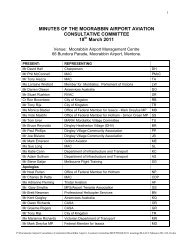Circuit Training at Moorabbin Airport Circuit Training at Moorabbin ...
Circuit Training at Moorabbin Airport Circuit Training at Moorabbin ...
Circuit Training at Moorabbin Airport Circuit Training at Moorabbin ...
You also want an ePaper? Increase the reach of your titles
YUMPU automatically turns print PDFs into web optimized ePapers that Google loves.
9.3.4. Can capacity caps be introduced to limit the total number of aircraft<br />
movements <strong>at</strong> <strong>Moorabbin</strong> <strong>Airport</strong> in total?<br />
<strong>Moorabbin</strong> <strong>Airport</strong> does not have a capacity cap. It has a movement forecast which is<br />
currently 500,000 movements by the year 2039. In 2009 the number of movements was<br />
310,000 and the 500,000 capacity would be reached with an incremental growth of 1.5% pa.<br />
DVCA want a capacity cap of 310,000 and a progressive reduction by 10% per year.<br />
RVAC:<br />
Present day economics has an enormous impact on the current training regime and therefore<br />
it is almost impossible to predict hours necessary to cover the training hours required to<br />
teach the unknown number of students each school may have enrolled in the future. Flying<br />
training is a multibillion dollar industry. Avi<strong>at</strong>ion relies and has a huge intern<strong>at</strong>ional market<br />
in flight training and it is in the best interest of the Federal and local governments as well as<br />
the local community to support the present infrastructure <strong>at</strong> <strong>Moorabbin</strong> <strong>Airport</strong> and wh<strong>at</strong> it<br />
stands for.<br />
Flying training for the purpose of conducting circuits is governed by the relevant training<br />
syllabuses issued by CASA.<br />
Oxford Avi<strong>at</strong>ion Academy:<br />
Setting a cap arbitrarily <strong>at</strong> 2009 levels and then reducing per annum is not acceptable from a<br />
business perspective. It sets up the airport for a slow de<strong>at</strong>h and would force flying schools to<br />
move. A quota system would be cumbersome and difficult to administer. If it had to be<br />
introduced, a monthly quota would be the most viable option to allow for we<strong>at</strong>her conditions<br />
and training p<strong>at</strong>terns.<br />
Tristar Avi<strong>at</strong>ion:<br />
No. Once again a restriction of trade issue. Merely an opportunity to reduce the viability of<br />
flying schools who should in no way be restricted from the opportunity of business growth,<br />
job cre<strong>at</strong>ion and business security.<br />
<strong>Moorabbin</strong> <strong>Airport</strong> Corpor<strong>at</strong>ion:<br />
MAC is not an airspace manager and does not have facilities or ability to oper<strong>at</strong>e such a cap.<br />
The ludicrous idea comes to mind th<strong>at</strong> if a total movement cap of, say, 300,000 was put in<br />
place wh<strong>at</strong> would happen on a day in May when the 300,001 st aircraft wished to land?<br />
Would the airport simply shut for two months?<br />
The Commonwealth has the ability, contained in the <strong>Airport</strong>s Act 1996, to require the airport<br />
to prepare a new ANEF if it (the airport) has reason to suspect th<strong>at</strong> the forecast may be<br />
exceeded. Under section 78 (2A) of the <strong>Airport</strong>s Act 1996 this would then trigger the<br />
establishment of a new Master Plan with associ<strong>at</strong>ed public consult<strong>at</strong>ion requirements.<br />
Airservices Australia:<br />
Capacity caps would require regul<strong>at</strong>ion. A booking system has been tried before and failed as<br />
slots are booked and not filled due to changing circumstances such as changes to the<br />
we<strong>at</strong>her, aircraft serviceability, etc.<br />
Airservices does not have the capability to manage such a proposed slot system.<br />
52




